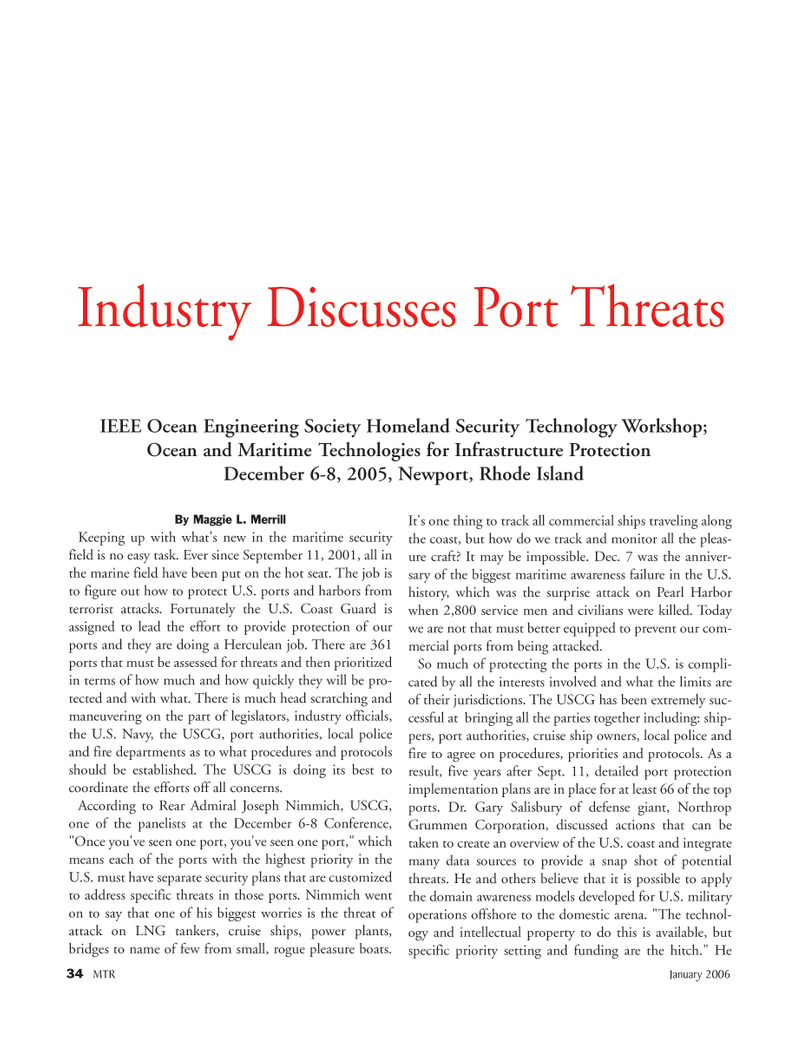
Page 34: of Marine Technology Magazine (January 2006)
Marine Science Institutions
Read this page in Pdf, Flash or Html5 edition of January 2006 Marine Technology Magazine
By Maggie L. Merrill
Keeping up with what's new in the maritime security field is no easy task. Ever since September 11, 2001, all in the marine field have been put on the hot seat. The job is to figure out how to protect U.S. ports and harbors from terrorist attacks. Fortunately the U.S. Coast Guard is assigned to lead the effort to provide protection of our ports and they are doing a Herculean job. There are 361 ports that must be assessed for threats and then prioritized in terms of how much and how quickly they will be pro- tected and with what. There is much head scratching and maneuvering on the part of legislators, industry officials, the U.S. Navy, the USCG, port authorities, local police and fire departments as to what procedures and protocols should be established. The USCG is doing its best to coordinate the efforts off all concerns.
According to Rear Admiral Joseph Nimmich, USCG, one of the panelists at the December 6-8 Conference, "Once you've seen one port, you've seen one port," which means each of the ports with the highest priority in the
U.S. must have separate security plans that are customized to address specific threats in those ports. Nimmich went on to say that one of his biggest worries is the threat of attack on LNG tankers, cruise ships, power plants, bridges to name of few from small, rogue pleasure boats.
It's one thing to track all commercial ships traveling along the coast, but how do we track and monitor all the pleas- ure craft? It may be impossible. Dec. 7 was the anniver- sary of the biggest maritime awareness failure in the U.S. history, which was the surprise attack on Pearl Harbor when 2,800 service men and civilians were killed. Today we are not that must better equipped to prevent our com- mercial ports from being attacked.
So much of protecting the ports in the U.S. is compli- cated by all the interests involved and what the limits are of their jurisdictions. The USCG has been extremely suc- cessful at bringing all the parties together including: ship- pers, port authorities, cruise ship owners, local police and fire to agree on procedures, priorities and protocols. As a result, five years after Sept. 11, detailed port protection implementation plans are in place for at least 66 of the top ports. Dr. Gary Salisbury of defense giant, Northrop
Grummen Corporation, discussed actions that can be taken to create an overview of the U.S. coast and integrate many data sources to provide a snap shot of potential threats. He and others believe that it is possible to apply the domain awareness models developed for U.S. military operations offshore to the domestic arena. "The technol- ogy and intellectual property to do this is available, but specific priority setting and funding are the hitch." He 34 MTR January 2006
Industry Discusses Port Threats
IEEE Ocean Engineering Society Homeland Security Technology Workshop;
Ocean and Maritime Technologies for Infrastructure Protection
December 6-8, 2005, Newport, Rhode Island
MTR#1 (33-48).qxd 1/9/2006 3:31 PM Page 34

 33
33

 35
35
